

This is the first sheep Digiferme in France: the Mourier experimental farm is celebrating its 20th anniversary in Haute-Vienne. Objective of this farm of the future: use new technologies to make life easier for breeders and make agriculture more attractive (First published on February 24, 2024)
An interregional center for information and research in sheep production, the Mourrier farm was created by the Chambers of Agriculture and the Livestock Institute to test innovations applied to breeding. It has around a hundred hectares and 700 sheep. The idea is to experiment, in real conditions, with practical and rapid applications that will improve the daily lives of farmers.
In her brand new building, Sophie Lavigne sorts her sheep. Single file, they wait quietly in a labyrinth of specially designed small corridors. Sorting usually requires a lot of labor and makes breeders sweat profusely, but here it is simplified by technology. As in an airport or at the entrance to a stadium, Sophie is armed with a scanner that reads the information contained in the beasts' loops. Information displayed on a touchscreen tablet. “It simplifies my work enormously because I don't need to record them on paper and I have no risk of error, of forgetting them to send them to the reform.”
The information is managed in a herd management software which allows you to follow its evolution in real time. After being scanned, the ewes go to automatic weighing. Here, each innovation must make life easier for breeders to make the profession more attractive. Latest test : high frequency loops: “We are going to record the movements of the animals, particularly before giving birth, to try to set up an alert system for breeders to say be careful, in this batch, there are some who are changing their status. behavior and who will give birth very quickly.”
The Mourier experimental farm is celebrating its 20th anniversary. An interregional information and research center in sheep production and the first sheep Digiferme in France, it was created by the Chambers of Agriculture and the Livestock Institute to test innovations applied to breeding. It has around a hundred hectares and 700 sheep. The idea is to experiment in real conditions and with practical and rapid applications the contribution of new technologies to make the lives of breeders easier and make the profession attractive.
•
©France Télévisions
Next test: a 3D imaging prototype. Porticos will be installed in the stall. They will make it possible to model animals in 3D to assess the body condition of ewes and lambs. This involves detecting weight loss or changes in body shape which could be warning signs of illness.
The farm is also experimenting with new breeding techniques to save time and money. Here, sheep graze quietly in plots usually occupied… by dairy cows. That's what we call coeducation.
“The sheep can clean the plots in winter, which will allow for better grass regrowth and better quality in the spring,” confides Mickaël Bernard, deputy director of the Interregional Center for Information and Research in Sheep Production.
“The interest is to see the impact on the cleaning of the plot. This will save us from going through the crusher, therefore saving time and especially diesel,” welcomes Jean-François Degeorges, dairy cow breeder. The advantage is also health. The maintenance of the plots by the sheep limits the proliferation of parasites for the cows. Another source of savings on veterinary treatments.
Another innovation is the testing of lamb food. In two enclosures, two groups of lambs are fed two different rations. The former have the classic ration based on fodder and cereals. The others only consume fodder produced on the farm. “We limit the economic cost of a ration and therefore the costs for the breeder. Since the fodder is produced on the farm, there is less dependence on world markets and we must ensure that the quality of the meat remains identical “, explains Mickaël Bernard.
For educational purposes, all of the farm's innovations are disseminated to a wide audience. More than 1000 people come to visit it each year for rapid transposition to farms throughout France. A large proportion of visitors are future breeders. This technological showcase allows us to present them with a more attractive profession, because it is relieved of the most physical and daunting tasks.



